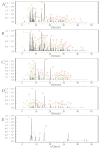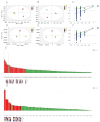The Discrimination and Characterization of Volatile Organic Compounds in Different Areas of Zanthoxylum bungeanum Pericarps and Leaves by HS-GC-IMS and HS-SPME-GC-MS
- PMID: 36429337
- PMCID: PMC9689319
- DOI: 10.3390/foods11223745
The Discrimination and Characterization of Volatile Organic Compounds in Different Areas of Zanthoxylum bungeanum Pericarps and Leaves by HS-GC-IMS and HS-SPME-GC-MS
Abstract
The pericarps of Zanthoxylum bungeanum (ZBP) and leaves of Zanthoxylum bungeanum (ZBL) are popular spices in China, and they have pharmacological activities as well. In this experiment, the volatile organic compounds (VOCs) of the pericarps of Zanthoxylum bungeanum in Sichuan (SJ) and its leaves (SJY) and the pericarps of Zanthoxylum bungeanum in Shaanxi (SHJ) and its leaves (SHJY) were analyzed by headspace-gas chromatography-ion mobility spectrometry (HS-GC-IMS) and headspace solid phase microextraction-gas chromatography-mass spectrometry (HS-SPME-GC-MS). The fingerprint of HS-GC-IMS and the heat maps of HS-SPME-GC-MS were established. Principal component analysis (PCA) and orthogonal partial least squares discriminant analysis (OPLS-DA) were performed. The results showed that a total of 95 components were identified, 62 components identified by HS-SPME-GC-MS and 40 components identified by HS-GC-IMS, of which 7 were the same. The analysis found that SJ and SHJ were obviously distinguished, while SJY and SHJY were not. There were considerably fewer VOCs in the leaves than in the pericarps. In the characterization of the VOCs of ZBL and ZBP, the flavor of ZBP was more acrid and stronger, while the flavor of ZBL was lighter and slightly acrid. Thirteen and eleven differential markers were identified by HS-GC-IMS and HS-SPME-GC-MS, respectively. This is helpful in distinguishing between SHJ and SJ, which contributes to their quality evaluation.
Keywords: Zanthoxylum bungeanum; fingerprint; headspace gas chromatography-ion mobility spectrometry; headspace solid phase microextraction-gas chromatography-mass spectrometry; orthogonal partial least squares discriminant analysis; principal component analysis.
Conflict of interest statement
The authors declare no conflict of interest.
Figures





References
-
- Zhang Z., Liu J., Shen P., Cao Y., Lu X., Gao X., Fu Y., Liu B., Zhang N. Zanthoxylum bungeanum pericarp extract prevents dextran sulfate sodium-induced experimental colitis in mice via the regulation of TLR4 and TLR4-related signaling pathways. Int. Immunopharmacol. 2016;41:127–135. doi: 10.1016/j.intimp.2016.10.021. - DOI - PubMed
-
- Jing N., Wang M., Gao M., Zhong Z., Ma Y., Wei A. Color sensory characteristics, nutritional components and antioxidant capacity of Zanthoxylum bungeanum Maxim. as affected by different drying methods. Ind. Crops Prod. 2021;160:113167. doi: 10.1016/j.indcrop.2020.113167. - DOI
Grants and funding
LinkOut - more resources
Full Text Sources
Miscellaneous

